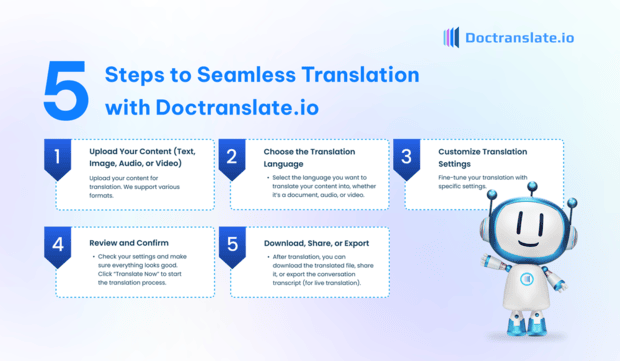Introduction
Breaking language barriers is crucial in our interconnected world.
Translating documents helps you connect with a global audience.
Whether for business, study, or personal use, accurate translation is key.
Doctranslate.io offers a simple and effective way to translate documents.
It supports various formats and languages, making the process easy.
This guide focuses on translating documents from Chinese to English using their platform.
Follow these steps for a smooth translation experience.
Step-by-Step Guide: Translating Documents from Chinese to English with Doctranslate.io
Step 1: Upload Your Content
The first step is getting your document onto the platform.
Navigate to the **Doctranslate.io** website.
Find the document translation section.
Click the upload area to select your file.
-
Supported formats include DOCX, PDF, PPTX, and XLSX.
Simply select the file from your computer.
The system will prepare it for translation quickly.
If you need to translate text only, use the text translation feature.
-
Copy and paste your text into the box.
It handles up to 5000 words at once.
It’s perfect for short pieces or specific sentences.
Need to translate an image containing text?
-
Upload your image file like JPG or PNG.
The platform extracts and translates the text.
Great for photos or scanned images.
Audio and video translations are also available.
-
Upload MP3 or WAV for audio.
Get transcripts and translations easily.
-
Upload MP4, SRT or provide YouTube links for video.
Translate subtitles or entire video content.
Step 2: Choose the Translation Language
After uploading, select your desired languages.
First, confirm the source language is Chinese.
Next, choose English as the target language.
Doctranslate.io supports a wide range of languages.
Making sure these are correct is essential for accuracy.
A simple dropdown menu makes selection quick.
Verify your choices before proceeding.
Step 3: Customize Your Translation Settings
Tailor the translation to meet your specific needs.
Customization options enhance translation quality.
Different content types have different settings.
For document translation, several options are useful.
-
Choose tone to match your document’s style.
Select a domain for specialized vocabulary.
Use ‘My Dictionary’ for custom terms.
Enable bilingual output if needed.
If translating text, you can adjust formatting.
-
Options include font type, size, and color.
Bilingual display is also an option here.
Image and video translations also offer customization.
-
Customize tone and domain for image text.
Utilize ‘My Dictionary’ for precision.
-
Video options include tone, domain, and bilingual output.
‘My Dictionary’ applies to text found in videos.
These settings help ensure high-quality results.
Refer to the **DocTranslate.io User Manual** for more details on professional modes.
Step 4: Review and Confirm
Before initiating the translation, take a moment to review.
Double-check your selected source and target languages.
Confirm that your customization settings are correct.
Ensure the document format was uploaded properly.
Once satisfied, locate the ‘Translate Now’ button.
Clicking this button starts the translation process.
The platform will begin processing your document.
Step 5: Download, Share, or Export
Once the translation is complete, you have options.
You can easily download the translated document.
The format will typically match the original.
Share the translated file directly if needed.
For audio or video, you might get transcripts.
These transcripts can often be exported.
The translated content is now ready for use.
Access your translated files quickly.

Conclusion
Translating documents from Chinese to English is straightforward with **Doctranslate.io**.
Their platform simplifies the entire process.
From uploading to customizing and downloading, it’s designed for ease.
You can achieve accurate and efficient translations.
Tailor the output using various settings like tone and domain.
Reach a wider, global audience effectively.
Break down language barriers for your content today.
Ready to translate your documents?
Visit Doctranslate.io to get started!


Leave a Reply